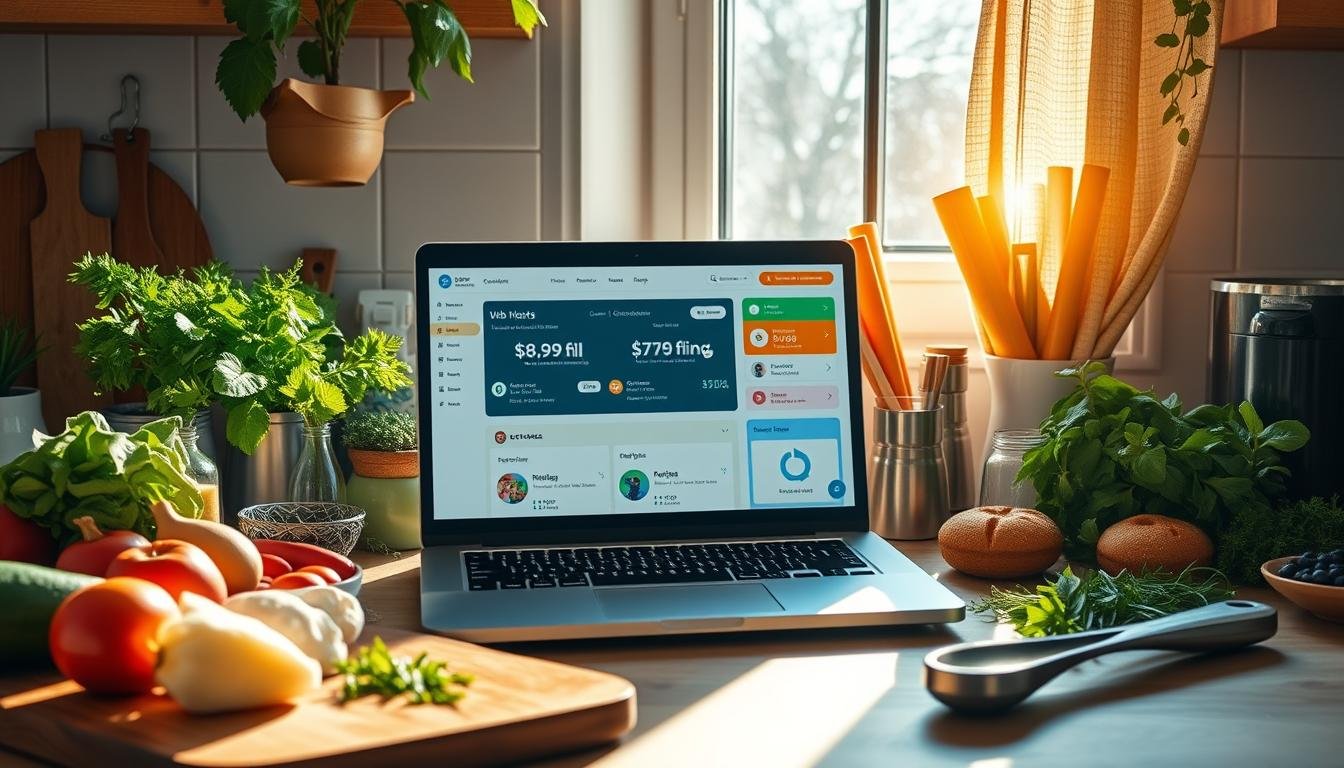Food bloggers in 2025 have a big choice to make. They need to pick the right web hosting provider to share their culinary passions online. PCMag Editors have tested over 10 years to find the top 11 web hosting services for food blogs.
But what makes these hosts special? How can you find the best one for your food blog? The answer is in knowing what makes a great web hosting service for food bloggers in 2025. This includes storage, performance, security, and WordPress integration.
So, what makes a web hosting provider stand out to food bloggers? Let’s dive into the best web hosting options. We’ll look at the key features that will take your culinary online presence to new heights in the future.
Key Takeaways
- Over 10 years of data from PCMag Editors on the best web hosting for food blogs in 2025
- 11 web hosting services identified as top choices for food bloggers
- Understanding the unique requirements of food blogs, including storage, performance, and security
- Emerging trends in web hosting, such as green hosting and AI integration
- Factors to consider when selecting the best web hosting for your food blog
Understanding Food Blog Hosting Requirements
Hosting a successful food blog needs careful thought. You need reliable hosting for food blogs. This is because your site will have lots of images and videos that take up space. Also, fast loading is key for a good user experience, which is important for recipe sites.
Storage Requirements for Food Bloggers
Food bloggers need lots of storage for their content. High-quality photos and videos can fill up space fast. Choosing a hosting plan with reliable hosting for food blogs and lots of storage is important. This ensures your content is always available to your audience.
Performance Needs for Recipe Websites
Speed is vital for high-performance hosting for culinary sites. Users expect recipe sites to load quickly, whether they’re cooking or baking. Hosting providers with SSD storage and CDNs can make your blog fast and smooth for visitors.
Security Considerations for Food Sites
Keeping your food blog safe is a must. Secure hosting for recipe sharing is essential. Your site may have original recipes and customer data. Look for hosting with strong security, like firewalls, SSL certificates, and backups. This protects your content and keeps your audience’s trust.
“Reliable, high-performance, and secure hosting are the cornerstones of a successful food blog in today’s digital landscape.”
Best Web Hosting for Food Blog: Top Market Leaders
Choosing the right web hosting is key for a successful food blog. Dreamhost, Bluehost, and Hostinger are top choices. They offer scalable hosting for growing food blogs, with reliable performance and strong security.
Dreamhost is known for its 100% uptime guarantee. They offer plans starting at $2.59 per month. You get lots of storage, unlimited bandwidth, and a free SSL certificate.
Bluehost has competitive prices and features for food bloggers. Their plans start at $2.95 per month. You get WordPress-optimized servers, lots of storage, and an easy-to-use dashboard.
Hostinger is great for those on a tight budget. Their plans start at $2.49 per month. They offer a user-friendly interface, WordPress features, and reliable performance.
These top providers offer scalable solutions and managed hosting. They have the tools you need for your food blog to succeed online. By choosing them, you can focus on your content while they handle the tech.
“Choosing the right web hosting provider is key for your food blog’s success. These top providers offer the scalability, performance, and features you need.”
Essential Features for Culinary Website Hosting
When you host your food blog or culinary website, some features are key. Hostinger website hosting is a good start, as it’s the base of your online space. But, there are more features that can make your website hosting for small businesses stand out. They help you grow your business in the competitive online food world.
Content Delivery Networks for Food Images
Great food photography is vital for any culinary website. To make sure your images load fast, look for a hosting provider with a Content Delivery Network (CDN). A CDN stores your media on servers around the world. This makes your site faster and better for users everywhere.
Backup Solutions for Recipe Databases
Your recipes are the heart of your blog or website. Keep them safe with strong backup solutions from your host. Automated backups protect your recipes, so you won’t lose them if something goes wrong.
WordPress Integration Capabilities
Most food bloggers use WordPress. So, it’s important to choose a host that works well with WordPress. Look for easy WordPress setup, pre-set WordPress environments, and WordPress support. This makes it easy to get online and grow your business.
By focusing on these features, your culinary website will offer a great user experience. It will also keep your content safe and make managing your site easier. With the right hosting, you can share your culinary creations with the world.
Performance and Speed Optimization Tools
Running a successful food blog means your website must perform well. Your readers want a smooth experience, and slow sites can lose them. Luckily, many web hosts offer tools to boost your site’s speed and performance.
Affordable web hosting like Hostinger, Nexcess, and InterServer are great for WordPress users. They use SSD storage, caching, and fast servers for quick load times, often under 1 second.
For example, Hostinger loads in 0.719 seconds. Nexcess and InterServer offer times from 0.046 to 3.43 seconds, based on where your visitors are. Choosing a host close to your audience can make your site even faster.
| Web Hosting Provider | Average Load Time | Optimized Features |
|---|---|---|
| Hostinger | 0.719 seconds | SSD storage, caching, performance-tuned servers |
| Nexcess | 0.046 – 3.43 seconds | Data centers near target audience, managed WordPress hosting |
| InterServer | 0.046 – 3.43 seconds | Unlimited SSD storage, data transfer, and sites |
Using these affordable web hosting providers’ tools, food bloggers can make their sites fast and engaging. This leads to more visitors and success online.

Pricing Comparison of Top Food Blog Hosts
Hosting your food blog can cost differently based on what you need. There are options for beginners and professional bloggers. Each offers unique features and prices to fit your budget.
Budget-Friendly Options for Beginners
HostGator and Bluehost are great for newbies. HostGator starts at $2.59 a month for small sites. Bluehost offers plans from $2.95 a month with a 30-day money-back guarantee.
Premium Plans for Professional Food Bloggers
For bigger sites, Liquid Web and DreamHost are top choices. Liquid Web has powerful VPS plans for big businesses. DreamHost is great for growing sites with its cloud hosting.
Hidden Costs to Consider
Be careful of hidden costs when choosing a host. These can include domain renewal fees and extra support. Always check the fine print and consider long-term deals for better value.
| Web Host | Shared Hosting Plans | VPS/Cloud Hosting Plans | Promotional Deals |
|---|---|---|---|
| HostGator | $2.59/month | N/A | 73% off Hatchling Plan ($2.99/month) |
| Bluehost | $2.95/month | N/A | 75% off Choice Plus Plan ($3.95/month) |
| Liquid Web | N/A | $8.85/month (Essential Plan) | 85% off 3 months ($8.85/month) |
| DreamHost | $2.59/month | N/A | 97-day money-back guarantee |
Security Features and SSL Certificates
Web hosting security is key in today’s digital world. Food bloggers handle sensitive info like recipes and user data. It’s important to choose a host that keeps your site safe.
Look for hosts with free SSL certificates to protect your site. Hostinger, for example, offers free SSL with every plan. This means your food blog is secure with the latest encryption.
- Hostinger also provides regular weekly or daily backups to prevent data loss, safeguarding your valuable content.
- Their hosting plans come with DDoS protection to shield your website from costly downtime caused by cyber attacks.
- Hostinger’s network monitoring and 24/7 infrastructure status page ensure you’re always informed about the health of your web hosting services.
It’s also important to use SFTP (Secure File Transfer Protocol) for data transmissions. Regularly update your web applications to fix vulnerabilities. Cloudflare’s web application firewall (WAF) adds extra protection against cyber threats.
By focusing on security and picking a reliable host, your food blog will be safe and ready for your audience.
Green Hosting Solutions for Eco-Conscious Food Bloggers
More people now want to live sustainably, including food bloggers. They look for web hosting that matches their green values. Green hosting uses renewable energy and energy-saving data centers, making it a great choice for these bloggers.
Sustainable Hosting Practices
Top green hosting providers use renewable energy like solar, wind, and hydroelectric power. This cuts down their carbon emissions. By picking a green host, food bloggers know their site is hosted in an eco-friendly way.
Carbon Offset Programs
Some green hosts also have carbon offset programs. These programs fund projects that reduce greenhouse gases. This makes the hosting services more eco-friendly. Food bloggers can show their commitment to the environment by choosing a host with carbon offsetting.
Energy-Efficient Data Centers
Today’s data centers are built to save energy. They use smart cooling systems and efficient hardware. Green hosting focuses on these energy-saving features, making the infrastructure behind food blogs more eco-friendly.
When picking a web host for their food blogs, bloggers should look for hosts that care about the planet. Choosing green hosting helps make the digital world more sustainable. It also shows their commitment to the environment to their readers.
| Green Hosting Provider | Renewable Energy Sources | Carbon Offset Programs | Energy-Efficient Data Centers |
|---|---|---|---|
| GreenGeeks | 100% renewable energy | Offset 3 times the energy used | LEED Gold certified data centers |
| Hostinger | 100% renewable energy | Offset 100% of carbon emissions | Energy-efficient server hardware |
| Siteground | 100% renewable energy | Offset 100% of carbon emissions | Highly optimized data centers |
Scalability and Growth Options
As your website management and web hosting reviews needs grow, it’s key to choose a Hostinger website hosting partner. They should be able to scale up smoothly to support your blog’s growth. Look for hosts that make it easy to upgrade to higher plans. This way, your site can handle more traffic and storage needs without any issues.
For food bloggers looking for more, VPS (Virtual Private Server) and dedicated hosting are great options. Dreamhost’s VPS plans, for example, offer up to 8GB of RAM and 240GB of SSD storage. They’re perfect for growing sites.
It’s also vital to be able to move your blog easily as it expands. Make sure your host has simple migration tools. Also, they should support multiple data centers. This lets you reach a global audience without losing performance.
“As my food blog grew, I needed a hosting solution that could keep up with the increasing demand. Hostinger’s scalable plans and easy migration options made it a breeze to transition to a more robust setup.”
Choosing a web hosting provider that focuses on scalability and growth is smart. It helps future-proof your food blog and opens up new success paths.

Customer Support and Technical Assistance
For a successful food blog, good customer support and tech help are key. Being able to quickly fix problems, like platform issues or server speed, is vital. It keeps your online presence smooth and efficient.
24/7 Support Availability
The top web hosts for food blogs have support available all day, every day. This means your questions and problems get solved fast, anytime. Hostinger, for instance, offers live chat, email, and phone support 24/7.
WordPress-Specific Support
Many food bloggers use WordPress for their sites. So, having support just for WordPress is super helpful. Bluehost and DreamHost have teams of WordPress experts. They can quickly solve any WordPress-related problems, making blogging easier.
Knowledge Base Resources
Great web hosts also have big knowledge bases and learning resources. These include tutorials and guides. They help you solve many technical problems on your own. This means you don’t need to ask for help as much, keeping your workflow efficient.
